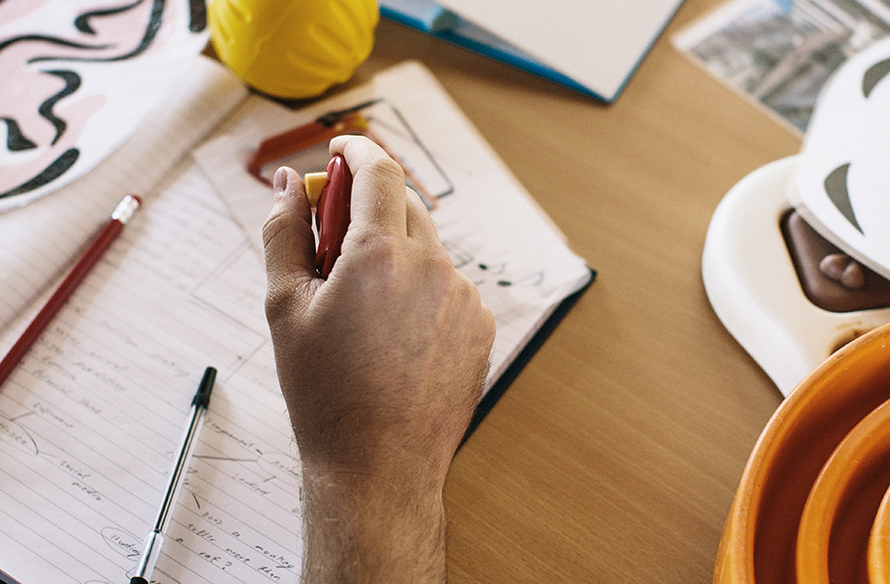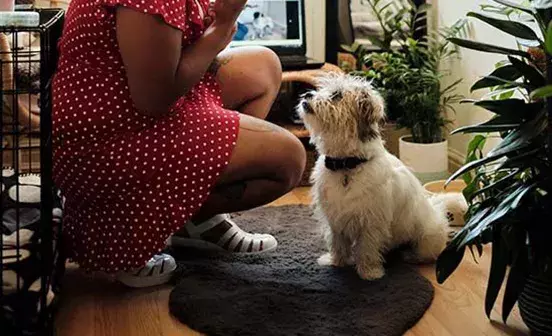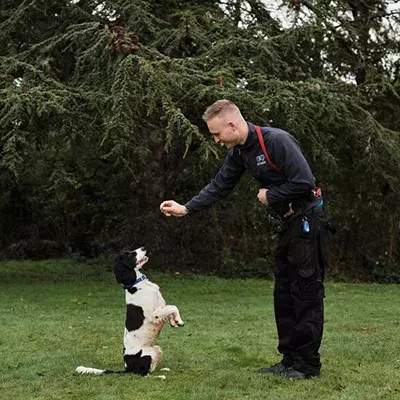In our dog behaviour series, you will learn how to train your dog using positive reinforcement, guided by our expert Canine Behavioural Team.

Dogs learn by making positive associations. For instance, if your dog is always given their favourite treat when they sit, they will associate sitting with their favourite things.
Repetition is key when it comes to training your dog. In order to avoid confusion, any behaviours that you do not want your dog to repeat should be ignored. Instead, you could teach them a behaviour that you can reward. For example, a dog who jumps up for attention could learn to sit to receive attention as an alternative.
Watch our 'Introduction to Training' video guide, it's a great way to start learning the basics of training.
How to reward your dog
Rewards come in all shapes and sizes, and it’s important to work out what motivates your dog. This can change throughout the day. First thing in the morning being let out to go to the toilet is rewarding, but once that is done, the biggest reward might be breakfast. Out on a walk, when they are active, playing with toys may be the best reward for coming back to you. Work out what motivates your dog at different times and training will become much easier.
What to do when you can’t ignore your dog’s behaviour
Sometimes our dogs perform a behaviour that we do not want them to repeat but it is not possible to ignore it. In this situation, you can try to distract them with another behaviour e.g. asking them to sit.
The behaviour that you ask for would depend on the undesirable behaviour that your dog is showing, so you should aim to ask for a behaviour that is incompatible with the undesirable behaviour. For example, using a down command if a dog is jumping up at you. Ideally you then want to pre-empt the undesirable behaviour and ask for the incompatible one first, so you can focus on positives.
When to reward your dog
Rewards come in all shapes and sizes, and it’s important to work out what motivates your dog. This can change throughout the day. First thing in the morning being let out to go to the toilet is rewarding, but once that is done, the biggest reward might be breakfast. Out on a walk, when they are active, playing with toys may be the best reward for coming back to you. Work out what motivates your dog at different times and training will become much easier.
What to do when you can’t ignore your dog’s behaviour
Sometimes our dogs perform a behaviour that we do not want them to repeat but it is not possible to ignore it. In this situation, you can try to distract them with another behaviour e.g. asking them to sit.
The behaviour that you ask for would depend on the undesirable behaviour that your dog is showing, so you should aim to ask for a behaviour that is incompatible with the undesirable behaviour. For example, using a down command if a dog is jumping up at you. Ideally you then want to pre-empt the undesirable behaviour and ask for the incompatible one first, so you can focus on positives.
When to reward your dog
The timing of your reward is crucial for effective communication with your dog. Bad timing can result in encouraging an unwanted behaviour. For example, if your dog barks at the front door and you throw food to distract them, you may end up encouraging the barking because it is being reinforced by the food.
Delivering the reward as soon as your dog has completed the desired behaviour will help them to understand what you want. For instance, if you are teaching your dog to sit then you would need to be quick so that you reward when your dog is still sitting rather than when they’ve just got up.
At Battersea, we often use clickers to “mark” desired behaviours because they are a very clear, short sound that can help to snapshot the desired behaviour. We can also use a specific word instead of the clicker like “yes”.

How to clicker train your dog
Clicker training is a positive, reward-based training method which relies on consistency, repetition and positive reinforcement. The way you train your dog is the same, but the clicker provides a clear signal that they’ve got it right and a reward is on the way, which can speed up your training process.
The clicker is a small box that makes a quick, clear, consistent and distinctive sound when pressed. It serves to accurately mark the behaviours that you want in your dog and provides them with clear information. Once your dog understands that the click marks the correct behaviour, you can use it to train any number of things.
Some dogs may be frightened of the click sound. There are many different clickers available on the market, some with adjustable volumes. You may wish to try putting a piece of sticky tack on the metal part of the clicker to soften the sound in extreme cases of noise fear or use a marker word rather than the clicker e.g. “yes”. With a marker word it is important that you choose a word your dog doesn’t hear a lot such as “good dog”.
Step by step guide to clicker training your dog
You will need your dog, a clicker and tasty treats.
First, you need to associate the sound of the click with a reward. You can easily do this by clicking and instantly giving a reward without asking them to perform anything. It will be clear that they understand the click when they look for the treat on hearing it. Always reward after the click to ensure they know that the click means they get a treat.
Once you have achieved this, you can progress to using the clicker to teach tricks, and also to focus and improve other behaviours.
To teach a command:
- With your dog focused on a treat, lure them into the position you require
- As soon as they are in the correct position, click and reward with the treat
- Repeat this until your dog is able to do the behaviour simply by hand signal
- You can then begin to add a word to the action
Keeping up motivation when training your dog
Once your dog is consistently performing a desired behaviour then it is not necessary to use food each time. Introducing them to different types of rewards will keep them interested in the task at hand. They should still get rewarded each time they perform the correct behaviour but sometimes this could be with verbal praise and other times with their favourite treat.
If they do something exceptionally well (either very quickly, or in a more distracting situation) you can give them a bigger “jackpot” reward, like cheese or chicken as well as lots of enthusiastic praise. This technique keeps your dog motivated and excited to do well.
Download the advice on this page as a handy advice sheet and to use as a reminder:


